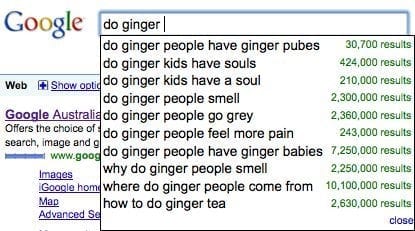Are Redheads Bleeders?
There is little doubt that redheads – also known by the G word in certain quarters – are subjected to considerable prejudice in many aspects of their lives. You disagree? Well let us turn to that all powerful social research tool, the Google search engine. Look what suggestions are offered – based on the popularity of previous searches – when you type “do ginger“:
This prejudice against redheads is nearly as pervasive as that against lefties (which I’ll leave for another occasion…) and no one expresses its impact better than our favo(u)rite Western Australian musico-comedic genius, Mr. Tim Minchin (includes colo(u)rful language of which your grandmother may disapprove):
I first became aware that redheads were treated differently in medicine when I started hanging around anaesthetists. Most anaesthetists i know tend to get slightly more uptight when they see the phaeomelanin-laden locks of a freckled UV-sensitive patient. Especially in obstetrics.
Why is this you ask?
“Because redheads bleed”, is the answer often given.
But is this just an example of confirmation bias? Do doctors selectively remember those of our redheaded patients that have bleeding complications or is there something to it? I’m not the first to ask this question but until now I haven’t known the answer.
Here is what my review of the literature came up with:
Redheaded children have similar rates of post-tonsilectomy hemorrhage as non-redheaded children.
Redheaded women have no difference on coagulation tests, platelet function tests or other laboratory-based haemostatic tests.
but…
Redheaded women do report more bruising than dark-haired women.
Why do redheads report more bruising? This finding came out of a study where the investigators were not blinded to the subjects hair colo(u)r, so observer bias, not to mention recall bias, may have confounded this finding. Given that their tests of haemostasis appear normal other factors may be important. Perhaps bruises are more noticeable in those with fair skin. Differences in vascular fragility and non-detectable haemostatic factors, or simply redhead-specific female clumsiness, cannot be excluded.
Anaesthetists are right though, redheads are different: they have greater anesthetic requirements than non-redheads. Liem and colleagues suggest that having red hair may be a distinct phenotype (linked to a specific genotype characterised by a melanocortin-1 receptor mutation) that makes them less sensitive to the anesthetic gas desflurane. Again, this study was performed on women only, who are thought to manifest the effects of melanocortin-1 receptor mutations to a greater degree than men. An alternative hypothesis may be that the anaesthetist’s anxiety about having a ‘redheaded bleeder’ in the operating theatre is contagious, causing the redheaded patient to become more anxious and thus need more gas…
But could there still be another reason for the bleeding prejudice against redheads? Perhaps it is the inevitable association of red hair with ginger (of the Zingiber officinale variety). Ginger is commonly used as spice but is also used by herbalists to treat symptoms such as cough, abdominal pain, diarrhoea, nausea and motion sickness. Of greater relevance is that ginger can give people a tendency to bleed. Ginger may interact with the anticoagulant warfarin, inhibit platelet aggregation (by inhibition of thromboxane production from arachidonic acid) and increase fibrinolysis. So, it appears that ginger and bleeding are linked after all.
There you have it, it looks like gingers, sorry, I mean redheads, are normal people after all. They may even have souls.
References
- Favaloro EJ (2006). Increased propensity to bruising in red-haired females: a possible role for von Willebrand factor? Anesthesia and Analgesia, 103 (6), 1622-3 PMID: 17122291
- Kumar VV, Kumar NV, & Isaacson G (2004). Superstition and post-tonsillectomy hemorrhage. The Laryngoscope, 114 (11), 2031-3 PMID: 15510037
- Lesho EP, Saullo L, & Udvari-Nagy S (2004). A 76-year-old woman with erratic anticoagulation. Cleveland Clinic Journal of Medicine, 71 (8), 651-6 PMID: 15449760
- Liem EB, Hollensead SC, Joiner TV, & Sessler DI (2006). Women with red hair report a slightly increased rate of bruising but have normal coagulation tests. Anesthesia and Analgesia, 102 (1), 313-8 PMID: 16368849
- Liem EB, Lin CM, Suleman MI, Doufas AG, Gregg RG, Veauthier JM, Loyd G, & Sessler DI (2004). Anesthetic requirement is increased in redheads. Anesthesiology, 101 (2), 279-83 PMID: 15277908
Chris is an Intensivist and ECMO specialist at The Alfred ICU, where he is Deputy Director (Education). He is a Clinical Adjunct Associate Professor at Monash University, the Lead for the Clinician Educator Incubator programme, and a CICM First Part Examiner.
He is an internationally recognised Clinician Educator with a passion for helping clinicians learn and for improving the clinical performance of individuals and collectives. He was one of the founders of the FOAM movement (Free Open-Access Medical education) has been recognised for his contributions to education with awards from ANZICS, ANZAHPE, and ACEM.
His one great achievement is being the father of three amazing children.
On Bluesky, he is @precordialthump.bsky.social and on the site that Elon has screwed up, he is @precordialthump.
| INTENSIVE | RAGE | Resuscitology | SMACC

